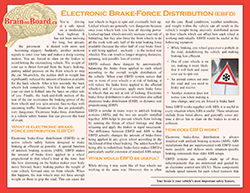Electronic Brake-force Distribution
Visual rebranding is underway. Check for the new logo to ensure you're accessing the most current version.
Lorem ipsum dolor sit amet, consectetur adipiscing elit. Morbi sed finibus metus, ac lobortis ante. Donec in suscipit augue. Nulla fringilla tempus ante congue tincidunt. Donec ligula nulla, tristique ut turpis quis, congue volutpat enim. Quisque tempor dictum accumsan. Phasellus faucibus blandit magna, vel tincidunt dolor laoreet vitae. Maecenas sodales iaculis libero non efficitur. Ut consequat tempor dolor, vitae interdum diam placerat a. Donec vitae eros id orci dignissim dapibus sed in lacus. Phasellus quis metus sit amet augue vehicula volutpat. Suspendisse sapien quam, convallis nec vestibulum non, sodales a ipsum.
What is electronic brake-force distribution (EBFD)?
Electronic brake-force distribution (EBFD) is an active vehicle safety feature designed to make braking as efficient as possible. As the name suggests, EBFD distributes braking power according to which wheels are braking most effectively at the time. To illustrate, just as heavy braking causes a driver’s body to move forward, slamming on the brakes also pushes the weight of the vehicle forward so the front wheels bear the most weight. When this happens, the rear wheels may not have enough grip on the road. This could cause the rear wheels to spin and eventually lock up. Locked-up back wheels not only increase the risk of fishtailing, but also force the front wheels to do all the braking work with only half of the total brake force available (since the other half is still being applied – uselessly – to the back wheels). This can result in longer stopping distances and an increased risk of collision.
EBFD reduces these dangers by automatically balancing the brake force applied to each wheel according to the overall weight distribution of the vehicle. The safety systems not only prevents wheel lockage by reducing brake force to spinning wheels, but can also allocate more brake-force to wheels that it detects are already braking effectively.
When would EBFD be useful?
While it may seem like all the tires bear the vehicle’s weight evenly, this is rarely the case. EBFD is useful whenever a driver brakes while the vehicle’s weight is unevenly distributed across all four tires. As such, EBFD is useful anytime a driver must slam on the brakes to avoid a collision, for example:
- While braking, one wheel goes over a pothole, making braking less efficient.
- One of the wheels is on ice and threatening to lock up during an episode of braking.
- A large animal comes out into the road, forcing you to brake and swerve.
How does EBFD work?
EBFD is always installed with anti-lock braking systems (ABS) and works very similarly to ABS. The important difference between EBFD and ABS is that while both systems prevent wheels from locking, EBFD can also redistribute brake-force according to which wheels are performing better. EBFD systems are usually made up of several components:
- Speed sensors that monitor the rotational speed of each wheel;
- Brake-force modulators that increase or decrease brake-force to each wheel;
- An acceleration/deceleration detector that monitors changes in the vehicle’s forward and side-to-side speed;
- A yaw sensor that monitors a vehicle’s side-to-side movement, and;
- An electronic control unit (ECU) that compiles information from all the sensors and gives commands to the brake-force modulators.
As with modern ABS setups, the brake-force modulators and ECU are attached together, so while they have different functions, they appear as one unit. The ECU monitors each wheel’s responsiveness to the brake, and then tailors the amount of brake force applied to each wheel. If the EBFD system senses that one of the wheels is about to lock, or that the car is swaying too much from side-to-side, it redistributes brake force to obtain optimal braking power.
How effective is EBFD?
EBFD promises several benefits in addition to improved stability and reduced stopping distance. EBFD will help a vehicle stop sooner, which lessens the effects that heavy braking has on the body (i.e., throwing the body forward towards the steering column). Furthermore by automatically adjusting brake-force to its optimal distribution, EBFD can reduce the effects of weather, road conditions, total weight of the vehicle, and the distribution of weight within the vehicle, thereby making braking more predictable.
The benefits of EBFD alone have not been widely tested. However, since it complements ABS, EBFD can be expected to at least match the effectiveness of ABS. More specifically, EBFD is designed to help drivers stop sooner, while ABS is designed to help driver retain steering control. When paired together, the odds of avoiding a crash by either stopping before impact or braking and swerving out of danger increase.
Does EBFD have any limitations?
Yes. As with most vehicle safety systems, realizing the benefits of EBFD depends on whether drivers understand its design limits, overall purpose, and interact with it appropriately. The goal of EBFD is to provide drivers with optimal braking efficiency. It cannot warn drivers of impending collisions or bad road conditions, so drivers must remain attentive and responsive to potential hazards. In addition, EBFD is only useful at speeds under a certain threshold. Beyond a safe speed, it may be impossible to combine EBFD braking power with safe steering directions.
Whether or not EBFD benefits drivers depends on how quickly they react to hazards and how safely they steer to avoid them. Speeding, driving while fatigued, driving while distracted, tailgating, and driving in bad weather can all negatively affect the benefits of EBFD because these behaviours impair a driver’s ability to react to obstacles and drive safely. The good news is that as long as drivers continue to drive safely and attentively they will accrue all the safety benefits EBFD has to offer.
How common is EBFD in today’s vehicles?
EBFD began being installed with ABS in the mid-2000s. Most modern ABS systems now include EBFD as a standard or optional add-on. In the model year 2010, 89% of cars and 99% of new light trucks had ABS installed; however there are no data on how many of these ABS systems included EBFD. Since Transport Canada does not require that ABS be installed on new vehicles, the best way to find out whether your vehicle has EBFD is to consult the owner’s manual.
Related Videos
Play Video



